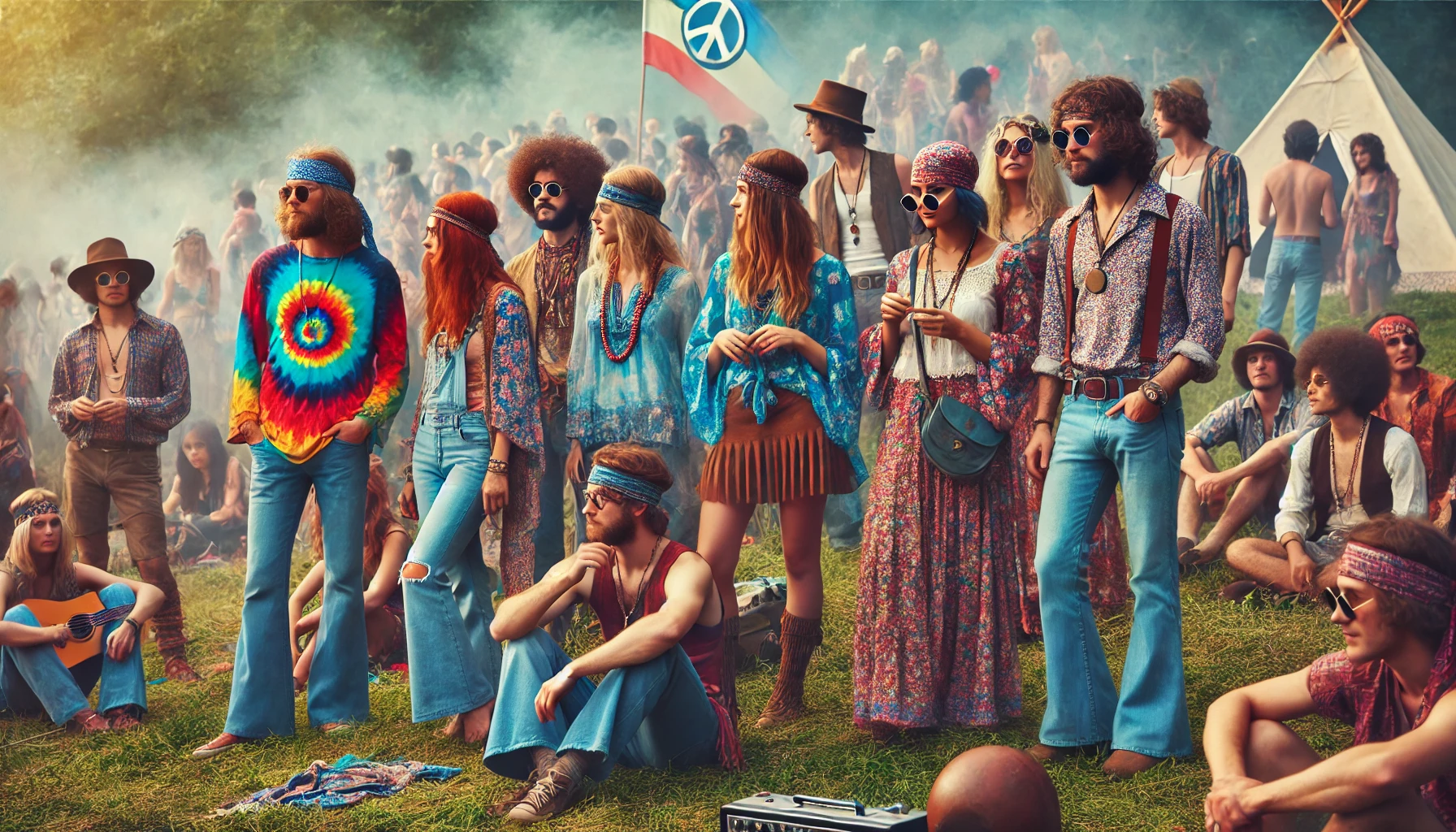Introduction to Hippie Fashion
Hippie fashion is a style that grew out of the 1960s and 1970s counterculture movements. This style is all about freedom, peace, and love, reflecting the values of the people who embraced it. It originated during a time of significant social, political, and cultural shifts.
As people protested against wars and fought for civil rights, their fashion choices became a powerful form of expression. Hippie outfits often include colorful, loose-fitting clothing, floral patterns, and accessories like headbands and beads. This fashion isn’t just about looking different; it’s deeply tied to the ideas of breaking free from societal norms and promoting peace.
Historical Context and Evolution of Hippie Fashion
Hippie fashion began in the late 1960s, influenced by anti-war movements and a drive for personal freedom and expression. This era saw young people rebelling against strict societal norms through their distinctive style choices. Originally, the movement drew inspiration from vintage and ethnic clothing, reflecting their ideals of peace and love.
As travelers explored new cultures, they brought back styles and fabrics, enriching the hippie wardrobe with diverse, global influences. Throughout the 1970s, this fashion evolved to become a symbol of youth and freedom, with its impact still visible in today’s fashion world.
Key Elements of Hippie Fashion
The iconic look of hippie fashion features several distinctive garments. Bell-bottoms and tie-dye shirts symbolize the era, showcasing a love for bold colors and patterns. Peasant blouses and maxi dresses also play a significant role, offering comfort and a touch of feminine grace.
These clothes were often made from natural materials like cotton, hemp, and linen, emphasizing sustainability and a connection to the earth. This preference for natural fibers was not only a style statement but also a nod to the hippie’s environmental and ethical values.
Iconic Accessories and Footwear
Accessories were vital in completing the hippie look. Essential items included headbands and turbans, which were both stylish and symbolic of the movement’s ethos. Oversized sunglasses and jewelry crafted from natural materials like wood, stones, and beads were also popular, adding personality to every outfit.
Footwear choices like sandals, clogs, and platform shoes were favored for their comfort and style, making them perfect for both casual and more festive occasions. These accessories and footwear not only defined personal style but also echoed the hippies’ values of freedom and non-conformity.
Discover Mazu Fashion: Trendy, Comfortable, Quality Clothing
DIY and Personalization in Hippie Fashion
Hippie fashion stands out for its vibrant, personalized approach to clothing. Key techniques like tie-dye, embroidery, and the use of patches allow wearers to express their unique personalities. Tie-dye creates colorful, swirling patterns on fabric, making each piece one-of-a-kind. Embroidery adds a personal touch with detailed stitching that often features floral or abstract designs.
Patches are not just for repairs; they serve as expressions of personal beliefs, favorite bands, or political statements. This customization aligns with hippie ideals of individuality and self-expression, encouraging a direct connection between the wearer and their wardrobe choices.
Gender Norms and Fashion
Hippie fashion played a crucial role in redefining gender norms in clothing. The movement favored androgynous styles that blurred traditional gender lines. Both men and women embraced floral prints, loose-fitting caftans, and bell-bottom pants.
Accessories like beads, headbands, and sandals were worn by all, further mixing gender-specific fashion. This approach not only challenged the existing norms but also promoted a message of equality and freedom in personal style, allowing individuals to dress in ways that felt true to themselves without being confined by traditional gender roles.
Hippie Fashion’s Influence on Modern Styles
The impact of hippie fashion is still evident in today’s clothing trends, particularly in the boho-chic style. This modern fashion genre borrows heavily from hippie elements like flowing silhouettes, ethnic prints, and natural fabrics.
Boho-chic is known for its relaxed, earthy vibe that includes maxi dresses, fringed accessories, and layered jewelry, all reminiscent of the 1960s and 1970s hippie aesthetics. Designers and fashion influencers continue to draw inspiration from this era, blending vintage inspirations with contemporary fashion to create new, dynamic looks that resonate with a wide audience.
Sustainable and Ethical Fashion Practices
The hippie movement was early in championing sustainable and ethical fashion, a trend that has gained significant traction in today’s industry. Hippies preferred natural materials like cotton, wool, and leather, avoiding synthetic fabrics that were seen as products of corporate culture. They often chose secondhand clothing or handmade garments, reducing waste and promoting a more sustainable consumption model.
This philosophy aligns closely with contemporary movements for ethical fashion, which advocate for environmentally friendly practices, fair labor conditions, and transparency in clothing production. Today’s eco-conscious designers and brands draw inspiration from these principles, emphasizing organic materials, ethical sourcing, and durability over disposability.
Old Money Fashion [Secrets]: (Timeless) Elegance and Sophistication
Conclusion: The Legacy of Hippie Fashion
Hippie fashion has left a lasting imprint on the world of style. Its celebration of personal expression, bold patterns, and relaxed fits continues to influence modern designs. Today, elements of hippie style are visible in the popularity of vintage shopping, the resurgence of tie-dye, and the widespread acceptance of mixing prints and textures. The movement’s ideals—freedom, peace, and respect for the environment—resonate deeply in today’s fashion landscape, where more people seek meaning and sustainability in their wardrobe choices. Hippie fashion not only transformed how we dress but also why we dress the way we do, emphasizing that fashion is both a personal statement and a political one.
Step into the Fashion World with Dazzled Look. Explore our website for boundless inspiration!

